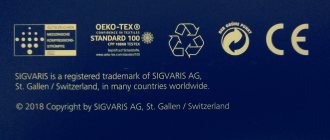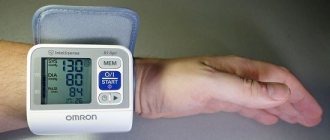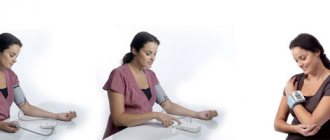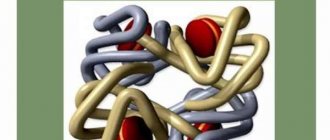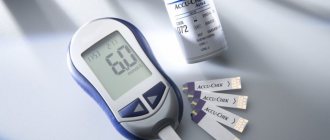When choosing products, you need to consider the size. To do this, the shin is measured above the ankle and at the top, and the length of the leg is measured from the foot to the knee. If you plan to purchase compression hosiery in the form of tights, measure your hip circumference and waist circumference. Take into account the length of the leg from the crotch to the foot.
Why do vein problems occur?
Varicose veins are dilation of the veins of the lower extremities, which is accompanied by impaired blood flow and incompetence of the valves that help move blood towards the heart. If the valve can no longer restrain the reverse flow of blood as before, then venous stagnation occurs. Dilated veins will become more noticeable, blood will move through them slowly, which means swelling and pain will appear in the lower extremities.
Time-tested method!
Even the builders of the ancient Egyptian pyramids knew that excessive stress on the lower limbs, hard work and prolonged standing on the feet provoke heaviness, swelling and varicose veins. That is why the Egyptians wrapped their limbs with tight bandages. Over time, the military began to use this invention. In the Russian army, military personnel wore “onuchi” - special compression bandages that helped withstand long distances on foot.
The ancestor of modern compression garments was an elastic bandage, which was originally used to tighten wounds. And from the middle of the last century to this day, special products with a compression effect have been used.
How not to buy a fake
To buy high-quality compression hosiery, you need to carefully choose the manufacturer. Unfortunately, fakes can often be hidden under well-known brands. Therefore, you need to buy underwear only from specialized retail outlets, and even better from certified distribution networks. In such networks, a company representative can give practical advice, take all the measurements himself and help you choose the right type of knitwear.
Medical compression garments have their own quality standards. The highest standard is European RAL-GZ-387. All manufacturers who use it on their packaging undergo certification in leading centers in Germany and Switzerland. The presence of such a certificate guarantees that compression products actually create a physiologically correct pressure distribution in the ratio of 100%/70%/40% and have a therapeutic effect. The standard must not only be printed on the packaging, but also on a label that is sewn into the product itself.
How does anti-varicose underwear work?
Compression hosiery has a compressive effect on the veins of the lower extremities and brings the leaflets of poorly functioning valves closer together, thereby protecting the veins from stretching and accelerating the outflow of blood. The healing properties are based on precisely calculated and dosed pressure on the venous wall; the compression is graduated - maximum at the ankle (100%), smoothly distributed along the leg, decreasing towards the thigh (up to 40%).
For production, special fibers and materials are used to ensure comfort and safety of use.
What are anti-varicose stockings for?
Anti-varicose stockings are very popular. Experts are of the opinion that if you wear this item of clothing constantly, not forgetting about taking medications and the necessary exercises, you can completely get rid of varicose veins.
Anti-varicose stockings are made of compression knitwear and are strictly for medical purposes. These stockings are able to support blood vessels without allowing them to stretch. It should be noted that today anti-varicose stockings are recognized as one of the most effective methods of combating varicose veins and a way to prevent this disease.
In addition to all this, specially created anti-varicose jersey prevents the formation of blood clots and has a positive effect on metabolism.
anti-varicose jersey
As prescribed by a doctor, even girls wear anti-varicose stockings starting at the age of 18, and sometimes earlier. Wearing stockings helps them to completely recover from vein diseases and avoid surgical intervention.
Types of compression garments
Each type of knitwear has its own functionality, which depends on the scale of the problem.
Anti-varicose tights
Like other products in this group, they have their own peculiarity: they have the least elasticity in the ankle area and the greatest elasticity in the waist area. Having such specific manufacturing, they nevertheless do not slip, do not bunch up on the knees and hold the fixation on the leg well. This ensures uniform distribution of pressure across the legs. The therapeutic effect will depend on how correctly and accurately you select the size of the product. Pay special attention to the elastic band - it should sit exactly on the waist in order for the therapeutic effect to be maximum. The underwear should not fit too loosely or tightly, but you should feel it fit snugly and have a lifting effect.
Anti-varicose tights for pregnant women
Special knitwear that takes into account the dimensional characteristics of pregnant women. During pregnancy, the risk of developing varicose veins increases. This is due to hormonal changes, in particular an increase in progesterone. Hormonal changes reduce the tone of blood vessels. That is why preventive methods of maintaining the health of the expectant mother are so important, and taking measures if the development of varicose veins is already observed. Anti-varicose jersey for pregnant women allows you to comfortably endure changes in the body and prevent adverse consequences for mother and baby.
Compression stockings
Fully comparable in effectiveness to tights. The choice of product is a matter of individual preference. The stockings tightly and tangibly maintain tone, preventing the veins from relaxing, eliminating swelling and relieving fatigue.
Anti-varicose knee socks
More often used at the initial stage of problems with the veins of the lower extremities, when swelling and heaviness appear. Within 10-20 minutes after you put on your knee socks, you can feel the positive effect. Also, knee socks are an excellent option for those who often travel by plane, since pressure changes reduce blood oxygen saturation, hypoxia develops, the blood thickens and the load on the venous valves increases.
Anti-embolic stockings
These are white stockings with an open toe, which reduce the risk of thrombotic complications in patients during the hospital and post-hospital stages of treatment, during operations and childbirth. Such features of the product allow the doctor to identify any changes in the limbs, since they are especially noticeable against a white background.
Caring for compression hosiery:
— if you need to wear compression stockings, tights or socks all the time, then it is better to purchase several pairs so that it is more convenient for you to change them. Linen that is worn frequently must be washed by hand, as particles of dust, leather, etc. can get stuck between the weaving of the threads and reduce the compression effect;
- if you wear anti-varicose stockings, carefully watch the silicone tape so that soap, creams, lotions and water do not get on it, otherwise the sticky properties of the silicone are reduced;
- carefully monitor the pedicure and manicure, as the slightest snags and hangnails can lead to damage to the knitwear;
- if you snag the product, do not cut or pull the threads and loops from the wrong side.
Compression classes of anti-varicose products
Compression is the degree of force with which the product compresses the lower extremities to bring relief, eliminate swelling and restore tone to the vessels and veins.
There are 4 classes:
- Compression class 1 (18-21 mm Hg) - recommended in the presence of visible changes in the veins, heaviness in the legs, cramps, unstable swelling, changes in hormonal levels, including in pregnant women.
- Class 2 (22-32 mm Hg) are prescribed after surgical interventions, in the presence of varicose veins, acute thrombophlebitis, and persistent edema.
- Class 3 (33-46 mm Hg) is used in the complex treatment of veins with severe chronic venous and lymphovenous insufficiency.
- Class 4 (more than 46 mm Hg) - for lymphedema, congenital anomalies of the veins.
Anti-embolic knitwear has 2 compression classes:
- Compression class 1 (18-21 mm Hg) is recommended for the prevention of thrombus formation during operations and childbirth;
- Compression class 2 (22-32 mm Hg) are prescribed for complex surgical interventions in people with pathology of the veins of the lower extremities.
Doctor's testimony
The recommendations of a phlebologist are the main thing that guides you when choosing medical knitwear. When selecting, the doctor must take into account how much varicose veins have developed in the patient, what concomitant diseases and complications there are, features of working conditions, level of physical activity and other factors. Based on the indications, the patient receives information about what type of underwear he needs and what the degree of compression should be.
Preventive tights are most often prescribed to pregnant women, as well as to those who are prone to varicose veins of the legs, have increased risk factors, endure physical activity, and frequent air travel. Tights with a therapeutic compression class are designed to treat various forms of the disease and its complications.
As a rule, the more serious the disease, the higher the compression class should be (although there may be exceptions if there are complications). Although stockings and sometimes knee socks are also used for these purposes, in some cases tights will be more comfortable. Treatment for all forms of venous insufficiency usually takes a long time, so patient comfort is of great importance.
If we talk about everyday wear, then tights perform the same tasks as stockings; there is no fundamental difference in their impact. The upper part of the tights and their waistband are elastic and do not exert pressure; they are only needed for a good fit so that the tights do not slip down. For the same reason, the waistband of such tights usually does not cause discomfort to pregnant women.
How to choose the right size?
With the same weight, build and height, the proportions and volumes of all people are different. And how effectively the underwear will work on your legs is directly dependent on how thick your legs are and how much the anti-varicose products will stretch on your legs. Each manufacturer produces its own size chart, but despite this, there are generally accepted patterns and standards. In order to choose the most correct size, which is guaranteed to provide a therapeutic effect, it is important to take the correct measurements:
- Find the round protruding bone on the ankle - the “junction” of the foot and lower leg. Measure the thinnest part of the shin. It is in this area that 100% compression is created.
- Mid-calf. Central point of the calf muscle. Mentally calculate the middle of the shin (along the “calf”) and take a measurement. At this point the compression will be at around 70%. When purchasing a golf course, this mark is moved under the knee.
- The next measurement point will be the mid-thigh circumference. The pressure at this point will be 40%.
- To select the size of stockings and tights, it is important to measure the length of the leg, which is measured from heel to groin, and when buying golf, from heel to knee.
- When purchasing tights, it is important to measure your waist and hips.
After all the measurements, compare the results with the table and choose the right size.
Anti-varicose underwear belongs to the class of goods that cannot be exchanged or returned, so choose these products as responsibly as possible so that money is not thrown away. Consult with specialists.
How to choose the right compression stockings
First of all, you need to remember that compression stockings are a specific type of knitwear. You can't buy them in a regular lingerie store. You need to go to a specialized store or pharmacy after taking the following measurements:
- circumference of the lower leg in the narrowest place, that is, in the ankle area;
- circumference of the lower leg at its widest point;
- thigh circumference;
- the distance from the heel to the hip, that is, from the floor to the subgluteal fold.
Experts recommend taking such measurements in the morning, when the legs have not yet had time to swell. The obtained data must be checked against the table on the packaging of the selected product and thus decide on the purchase. Experts recommend paying attention to the quality of the material. Typically, such underwear is made from cotton, lycra, nylon, microfiber, and most often a mixture of two or more threads. High-quality knitwear has a marking that indicates the manufacturer’s data, material, compression class, size, and laundry care requirements. There is no fundamental difference between underwear for men and women; differences may relate to design and color.
Custom sizes
What is important to know if your measurements do not fall within the standards of compression garment manufacturers:
- When choosing a product, you should give preference to knee socks in the case of non-standard ones, because the main thing is to create compression in the lower leg, where the manifestations of varicose veins begin and develop most clearly and actively. Or give preference to products with an open nose so that the medical product fits correctly.
- If your sizes are at the junction of two sizes, give preference to smaller sizes so as not to lose the compression effect.
- It is important to take all measurements in the morning, immediately after waking up. There is no swelling at this time.
Congratulations, you have made your choice! In order for the product to serve you effectively for a long time, you must follow these simple rules:
A little history
The founders of scientific medicine described in their works methods for healing trophic ulcers using various bandages and pressure bandages. That is, compression therapy has been around for many years. The history of industrial production of knitwear with compression properties began back in the distant 29th year of the last century in eastern Thuringia. At that time, Thurangia was the only place where medicinal knitwear was produced. Today, various products made from this material can be purchased in any city in the world. Naturally, compression underwear in general and compression stockings in particular are not a panacea for all problems, but such “clothing” significantly improves health, provides freedom of movement, reduces pain, and also promotes speedy recovery in the postoperative period. Compression stockings make the patient’s life more comfortable, so you shouldn’t ignore the advice of doctors, you need to try everything that can help cope with varicose veins!
Rules for putting on compression stockings.
- You cannot wear orthopedic knitwear like regular tights, that is, you cannot gather it into an accordion. It is necessary to put on slowly and consistently, straightening out any creases.
- A special donning device can make the donning process easier.
- If the product was removed during the day, then you need to put it on after resting your legs for 10-15 minutes in an elevated position.
- The feet should be dry; to facilitate the tightening procedure, the feet can be powdered with talcum powder or baby powder.
- It must be put on in the morning, immediately after sleep, without getting out of bed.
